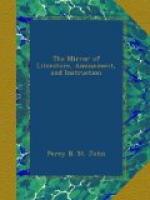[1] Occasioned by a transposition
of figures. In vol. xi.
referred to in the above page,
the date stands 1671.
There are many curious monuments in this church, and among others, is the beautiful one to the memory of Sir Richard Hoare, Knt. who was Lord Mayor of London in the memorable year 1745, at which “alarming crisis,” in the words of the inscription, “he discharged the great trust reposed in him with honour and integrity, to the approbation of his sovereign and the universal satisfaction of his fellow citizens.” He died in 1754, and was buried in this church. The monument, which is of marble, consists of a sarcophagus, above which is a cherub in the act of crowning a beautiful bust of Sir Richard with a laurel wreath, above is a shield of arms, within an orb ar. sa. a spread eagle of the first bearing an escutcheon of pretence ar. a lion ppr. in chief in base a chev. gu. charged with three escallop shells of the first, impaling a saltire sa. between four crosses fitche of the same. Crest, a griffin’s head erased ar. An inscription on the base informs us the monument was restored in 1820, at the expense of the parish, “in testimony of their grateful sense of obligation to a family whose eminent virtue and munificence it is intended to perpetuate.”
In the vestry of this church is preserved a finely executed portrait of the “Virgin Queen,” in stained glass; and there is also another window consisting of the effigy of St. Matthias, but this is not to be compared with the other for execution.
A.P.D.
* * * * *
CONSTANTINOPLE.
(For the Mirror.)
One of the finest buildings in Constantinople is a fountain in an open square, near the seraglio gate; it is a place built and maintained by the Grand Vizier, for the people to come and draw water, who have it served out to them in great jugs by people who are constantly in attendance to fill them; the jugs are chained to the place, and stand in rows about four feet from the ground, between gilt iron bars in front of the building. There are men always ready inside to draw the water and fill the jugs, which till people come are kept full; these men receive a yearly salary.
The houses are chiefly built of wood, and reach so far over the top that in some of the streets it would be very possible to get from the windows of one house to another across the street. By this manner of building, any one who has seen the place will not wonder at the frequent and fatal conflagrations there, for if once a fire break out it must burn till it comes to some garden or large vacant place to stop at. The Bussard is the most regular part of the city, and has a number of parallel streets crossing one another, and covered at the top with planks which keep out the rain and sun. Here all the richest and finest goods in Constantinople are put out to




